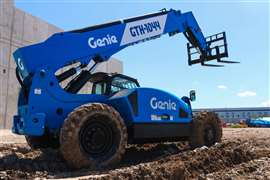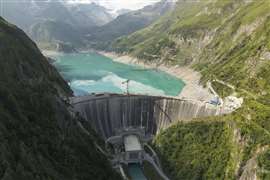Interview: Vision of unity
30 September 2013

Construction Products Europe, the association which represents Europe’s construction products manufacturers, has a vision in which the construction industry is more united, and the association plans to work more strategically with all parts of the construction process – from architects to contractors, and ultimately owners – so that it can develop a proactive strategy together.
Formerly called the CEPMC, Construction Products Europe made the name change on the same day that its new president took over.
The new president, Jean-Marie Vaissaire, said the association was on a new path, thanks to the previous president, and that it now wanted to target several main areas of action.
The first of these is a relaunch of the industry. “This,” he said, “would be created by significantly increasing the renovation rates of buildings, and also by the delivery of new efficient homes where they are needed.
“We must also focus on developing both the industry’s competiveness and sustainability through the delivery of efficient construction solutions.
“Finally, we aim to support the EU institutions in creating a reliable EU policy framework that supports the long-term investment needs of our industry.”
He added that in addition to this new strategy, the visual identity of the association had been revamped to support more effectively the new work it was undertaking.
Most of Vaissaire’s experience has been in gypsum and insulation businesses across Western European countries, starting out in a British group, BPB, and then Saint-Gobain. In 2012 he became director general of Saint Gobain Glassolutions and has also been president of AIMCC (the French construction product association) since 2009.
Motivating factors
There are many long-term motivating factors for the EU to focus on in construction. “First of all, the sector generates almost 10% of GDP and provides 20 million jobs in Europe. This is a huge chunk of the economy that is struggling and needs support.”
He said that solutions for higher energy efficiency in new and existing buildings that were key for the transformation of the EU’s energy system were already in place.
“Actions from the industry are essential to reach the 2050 greenhouse gas emission targets by the EU.
“Overall, there is a strong commitment to innovation in daily business practice and a willingness to participate in EU research programmes and industry platforms. What we therefore need to see now is investment from the EU to capitalise on what is occurring within the construction sector.
He said that as the construction sector has been going through hard times for several years, this led to an ever greater need of support from the European institutions.
He pointed out that in July 2012, the European Commission’s DG Enterprise presented the basis of a strategy aiming to relaunch the competitiveness in the construction industry for 2020.
“This strategy has created high expectations in our industry,” said Vaissaire.
“Another big topic for our sector is the question of how to assess the sustainability of a building. Our industry is increasingly dedicating itself to the development of sustainability in construction, but the question of what a sustainable building is continues to trigger discussions.”
He said it was very important to take into consideration the whole life cycle of the building to determine what was efficient and what was not, so that parts of a building don’t become counterproductive to the building as a whole. “This is more complicated than one would think,” he said.
Economic value
The strategy to achieve the association’s vision of a more united construction industry needs to create economic value, enhance resource efficiency, and contribute to social well-being, said Vaissaire.
“The challenge is finding a balance between all these requirements, while maintaining and even reviving the economic health of our industry. Taking all this into account, there is no denying that this is a challenging period for the construction sector.”
EU institutions will have a part to play. Vaissaire said, “At our last workshop in June, our message for the industry was clear – an EU policy framework that is coherent, reliable, predictable, stimulating.
“This means that we must ensure coherence and integration between all European construction policies to foster growth and promote efficiency.”
He said this should create a reliable framework that would guarantee a fair and open market for all competing players.
“It is important that policies are also predictable,” he said. “As a cyclical industry, the construction industry requires long-term investment and, therefore, long-term strategy and regulatory predictability.”
He added, “By making sure that the industrial landscape is as stimulating as possible, European players would be in a better position when facing competition from outside the region.”
Bearing this in mind, what the association would specifically like to see more from EU institutions was investment, and therefore regulatory incentives to drive growth.
“We also need to see innovative solutions to aid the construction industry. For example, not all solutions are found at European level – there are many good examples of solutions at local, regional and national levels, and these need to be co-ordinated to have a more positive influence on the rest of Europe.”
Vaissaire said everyone was aware European conditions for the construction market were very fragile at the moment, adding that there would be slow progress in the industry.
Signs of recovery
He pointed out that the European Construction Product Index had remained low for the first half of 2013, with some national markets showing signs of recovery.
“Overall we may have to accept that construction activity is likely to be weaker during 2013 than in 2012. Nevertheless, we should take a little comfort from the fact that there is a slight improvement in economic sentiment in Europe. This news should force us as an industry to work together and find solutions – of which there are many.
“We should take heed from countries where construction is still strong, and work together using our networks in Brussels as a focal point.”
Vaissaire’s presidency will last for two years, and over this time he said he wanted to see Construction Products Europe at the heart of the construction sector.
“The relaunch of the association started 13 months ago and we have already come a long way in regards to reorganisation. We now want to build on our structure and actively communicate on policy framework.”
STAY CONNECTED


Receive the information you need when you need it through our world-leading magazines, newsletters and daily briefings.
CONNECT WITH THE TEAM










